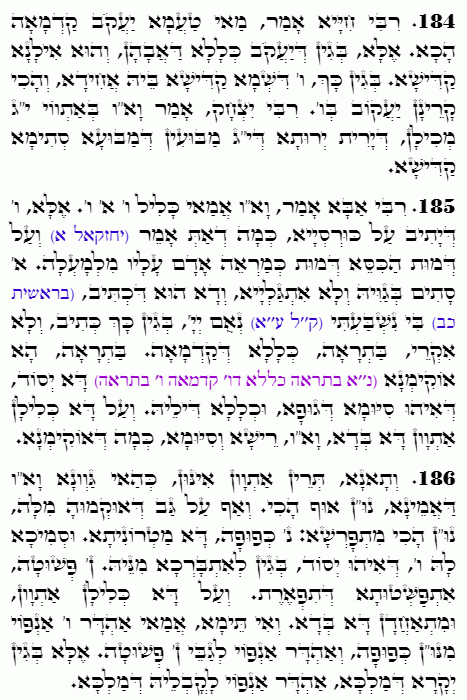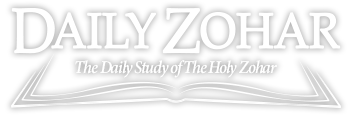Daily Zohar # 4634 – Acharei Mot – One additional letter, many words to explain
Daily Zohar 4634

Hebrew translation:
185. רַבִּי אַבָּא אָמַר, וָא”ו לָמָּה כּוֹלֶלֶת ו’ א’ ו’? אֶלָּא, ו’ שֶׁיּוֹשֵׁב עַל הַכִּסֵּא, כְּמוֹ שֶׁנֶּאֱמַר (יחזקאל א) וְעַל דְּמוּת הַכִּסֵּא דְּמוּת כְּמַרְאֵה אָדָם עָלָיו מִלְמָעְלָה. א’ נִסְתֶּרֶת בְּתוֹכוֹ וְלֹא מְגֻלֶּה, וְזֶהוּ שֶׁכָּתוּב (בראשית כב) בִּי נִשְׁבַּעְתִּי נְאֻם ה’, מִשּׁוּם כָּךְ כָּתוּב, וְלֹא נִקְרָא אַחֲרוֹן כְּלָל שֶׁל הָרִאשׁוֹן. הָאַחֲרוֹן, הֲרֵי בֵּאַרְנוּ (ו’ אַחֲרוֹנָה כְּלָל שֶׁל ו’ רִאשׁוֹנָה, ו’ אַחֲרוֹנָה) זֶה יה”ו יְסוֹד, שֶׁהוּא סִיּוּם הַגּוּף וְהַכְּלָל שֶׁלּוֹ. וְעַל כֵּן כְּלוּלוֹת הָאוֹתִיּוֹת זוֹ עִם זוֹ – וָא”ו, רֹאשׁ וְסִיּוּם, כְּמוֹ שֶׁבֵּאַרְנוּ.
186. וְלָמַדְנוּ, שְׁתֵּי אוֹתִיּוֹת הֵן, כְּמוֹ זֶה וָא”ו שֶׁאָמַרְנוּ, נוּ”ן אַף כָּךְ. וְאַף עַל גַּב שֶׁבֵּאֲרוּ אֶת הַדָּבָר, נוּ”ן כָּךְ מִתְפָּרֶשֶׁת: נ’ כְּפוּפָה זוֹ הַגְּבִירָה. וּסְמוּכָה לָהּ ו’, שֶׁהוּא יְסוֹד, כְּדֵי שֶׁתִּתְבָּרֵךְ מִמֶּנּוּ. ן’ פְּשׁוּטָה, זוֹ הִתְפַּשְּׁטוּת הַתִּפְאֶרֶת. וְלָכֵן כְּלוּלוֹת הָאוֹתִיּוֹת וְנֶאֱחָזוֹת זוֹ בָּזוֹ. וְאִם תֹּאמַר, לָמָּה מַחֲזִיר ו’ פָּנָיו מִנּוּ”ן כְּפוּפָה, וּמַחֲזִיר פָּנָיו אֶל הַן’ הַפְּשׁוּטָה. אֶלָּא בִּשְׁבִיל כְּבוֹד הַמֶּלֶךְ הוּא מַחֲזִיר פָּנָיו כְּנֶגֶד הַמֶּלֶךְ.
.
Zohar Acharei Mot
Continued from previous DZ
#184
Rabbi Chiya asks why Jacob is mentioned first in the verse, as it says, “And I will remember My covenant with Jacob” (Leviticus 26:42), followed by Isaac and then Abraham. He answers that it is because Jacob, who corresponds to Tiferet, encompasses the other patriarchs. Tiferet includes Chessed and Gevurah within itself, represented by Abraham and Isaac, respectively. Jacob is the holy tree, meaning Zeir Anpin, which consists of all six sides (the six sefirot). Therefore, the Vav (ו) of the holy name, YHVH, is associated with Jacob, and we read his name as “יַעֲקוֹב” “Yaakov” with the letter Vav (ו).
Rabbi Yitzchak said that Vav, when spelled out “ואו,” has the numerical value of 13, corresponding to the 13 attributes of mercy. Jacob, representing Zeir Anpin, inherits the 13 streams from the hidden, holy fountain, Arich Anpin. From the beard (Dikna) of Arich Anpin, 13 corrections flow down to Zeir Anpin, which is called Jacob. Therefore, Jacob is written with a Vav.
Notes:
The explanation of Jacob’s name with the letter Vav adds a deeper dimension, showing that this letter signifies his connection to the 13 attributes of mercy. This idea links Jacob, and by extension, Zeir Anpin, to the flow of mercy from Arich Anpin, the higher spiritual source. As the representative of Zeir Anpin, Jacob plays a central role in receiving and channeling the 13 attributes, making him the critical part of the covenant with God.
#185
Rabbi Abba said: Why is the letter Vav (ו) written with an Aleph (א) concealed within it when pronounced? He answers: The Vav represents Zeir Anpin, who sits upon the throne, the throne being Malchut, as it is written,
Ezekiel 1:26
“וּמִמַּעַל לָרָקִיעַ אֲשֶׁר עַל רֹאשָׁם כְּמַרְאֵה אֶבֶן סַפִּיר דְּמוּת כִּסֵּא וְעַל דְּמוּת הַכִּסֵּא דְּמוּת כְּמַרְאֵה אָדָם עָלָיו מִלְמָעְלָה.”
“And above the firmament over their heads was the likeness of a throne, in appearance like a sapphire stone; on the likeness of the throne was a likeness with the appearance of a man high above it.”
“the appearance of a man upon it from above,” referring to Zeir Anpin. The Aleph is concealed within the Vav and is not revealed, for Aleph represents Arich Anpin, which is clothed from the navel and below in Zeir Anpin and is not revealed outside of Zeir Anpin. This is what is meant by the verse.
(Genesis 22:16) “בִּי נִשְׁבַּעְתִּי נְאֻם יְהוָה” “By Myself have I sworn,” says Hashem, indicating that Zeir Anpin swears by Arich Anpin, which is clothed within him. Therefore, the Aleph is written but not pronounced. In other words, when we pronounce the Vav, the Aleph is silent and not heard in speech because it hints at Arich Anpin, which is concealed and incomprehensible.
The second Vav represents the entirety of the first Vav, and we have established that the final Vav represents Yessod, which is the conclusion of the body connected to Tiferet. The Yessod is the culmination of the body and includes the entirety of it. Therefore, these letters are intertwined with one another: the Vav, which is both the beginning and the end, represents Tiferet and Yessod, which are one. The Aleph represents Arich Anpin, dressed within Tiferet, as previously mentioned.
#186
It was taught: These two letters, in the manner that I have explained regarding the Vav, “ואו” also apply to the letter Nun, “נון.” Although this concept was established differently, the Nun can be understood as follows: the bent Nun (נ) represents the Malchut, and it leans toward the Vav, the Yessod, so that Malchut may be blessed through it. The straight (final) Nun (ן) represents the expansion of Tiferet. Therefore, the letters are intertwined and unified with one another because Tiferet, represented by the straight Nun (ן), influences Yessod, represented by the Vav (ו), and Yessod influences Malchut, represented by the bent Nun (נ).
If you ask why the Vav turns its face away from the bent Nun and turns toward the straight Nun, the answer is that it is out of honor for the King, who is Tiferet, represented by the straight Nun (ן). Therefore, as explained in the previous section, Yessod turns its face toward the King, which means that Yessod and Tiferet are always unified as one.
Notes:
The relationship between the Vav and the Nun is also highlighted, showing how Yessod turns toward Tiferet (the King) out of respect, symbolizing a deep connection between these two levels. This reflects the unity of the different aspects of the Holy King, where each level supports and sustains the others in a harmonious structure.
{||}

 Previous: Acharei Mot
Previous: Acharei Mot

